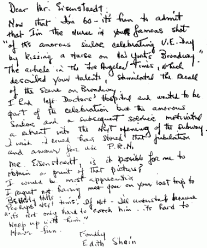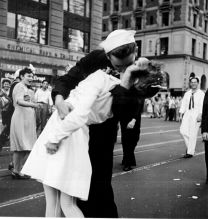The iconic posture from V-J Day photo is always deemed as a jubilant and loving embrace. People of today sculpture and reenact it in honor of this classic picture. However, a feminist blogger known only as “Leopard” wrote a post and put forward the question, “The Kissing Sailor, or ‘the Selective Blindness of Rape Culture’”. Leopard argues that this kiss is not just a kiss, but an act of sexual assault.
In this post, Leopard expresses disappointment that media outlets ignored intentionally or unintentionally what the “nurse” said about the victory day. It derives from the interviews with the sailor and the nurse, George Mendonsa and Greta Zimmer Friedman, who finally were identified by historians this year.
Greta said in the interview by the Library of Congress,
“It wasn’t my choice to be kissed. The guy just came over and grabbed!”
In another interview, she also told CBS,
“I did not see him approaching, and before I knew it, I was in this vice grip.”
(Click here to see: CBS interview V-J Day Times Square kiss couple reunited)
With these words from Greta, Leopard wrote,
“It seems pretty clear, then, that what George had committed would be considered sexual assault by modern standards.”
“Without a single acknowledgement of the problematic nature of the photo that her comments reveal, George’s actions are romanticized and glorified.”
Leopard’s remarks quickly evoked a great deal of voices of supporting and oppositions.
Some argue that this kiss happened in a special time, and cannot be valued in a modern perspective.“The man returned from war after saving his country. Overwhelmed with joy, pride, he kisses a beautiful woman, a symbol of what he fought so hard for. And are we going to rewind the clock and call that rape?” The netizen, Roger, retorts. Other opponents query that what if Greta herself doesn’t feel offended and assaulted.
In a new post titled “Debunking Misconceptions”, Leopard responds that his/her point is the silence of these media outlets concerning Greta‘s words rather than judging the sailor’s behavior. However, Leopard does write that the sailor’s ecstasy “does not extend to his impinging on someone else’s bodily autonomy”. Additionally, he/she counters that “Greta’s remarks about his strength and ‘vice grip [sic]’ don’t sound like the words of someone who had enjoyed the kiss. The fact is, consent was not given”. Some supporters also point out that the nurse clenching her fist in the picture expresses her unwillingness.
At last, Leopard explains the term “rape culture” he/she uses. “It is a culture where rape and other forms of sexual violence are normalized, to be expected. He/she thinks “if we ignore the fact that this kiss was not mutual, and insist on calling it romantic, then we send out the message that a woman’s bodily autonomy is not that important, and can be sacrificed under special circumstances”.
What do you see in the photos?








